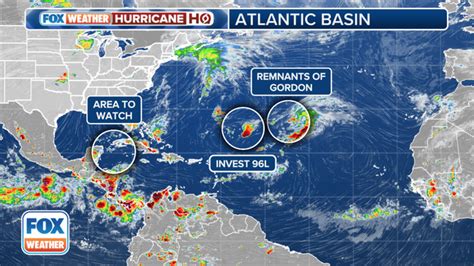
A potentially dangerous weather pattern is developing in the Atlantic, prompting experts to emphasize the need for coastal communities and residents to prepare for possible severe weather impacts. Forecasters are closely monitoring intensifying atmospheric conditions that could lead to the formation of significant storms, and they are urging individuals to review their emergency plans and stay informed about weather updates.
Meteorologists have identified a confluence of factors creating an environment conducive to storm development, including warmer-than-average sea surface temperatures and favorable atmospheric patterns. These conditions increase the likelihood of tropical cyclones rapidly intensifying into major hurricanes, posing substantial risks to life and property along the Atlantic coastline. The National Hurricane Center (NHC) is actively tracking several areas of interest and providing regular updates to keep the public informed.
The Atlantic hurricane season officially runs from June 1 to November 30, with the peak typically occurring between mid-August and late October. During this period, weather patterns often align to create conditions favorable for the formation and intensification of tropical cyclones. Warm ocean waters provide the necessary energy for these storms to develop, while low wind shear allows them to organize and strengthen.
According to the latest forecasts, sea surface temperatures in the Atlantic are significantly above average, particularly in the Gulf of Mexico and the Caribbean Sea. These elevated temperatures can fuel rapid intensification, where a tropical cyclone’s maximum sustained winds increase by at least 35 miles per hour within a 24-hour period. Rapid intensification can catch communities off guard and leave them with little time to prepare for the full impact of a major hurricane.
Experts are also monitoring atmospheric patterns, such as the Madden-Julian Oscillation (MJO), which can influence tropical cyclone activity. The MJO is a tropical disturbance that moves eastward around the equator and can enhance or suppress thunderstorm activity, depending on its phase. When the MJO is in a favorable phase, it can increase the likelihood of tropical cyclone formation and intensification in the Atlantic basin.
“We are closely watching several areas of interest in the Atlantic, and we urge residents along the coastline to be prepared,” stated a representative from the National Hurricane Center. “It is essential to have a plan in place, know your evacuation route, and stay informed about the latest weather updates.”
Preparedness is key to mitigating the impacts of severe weather. Emergency management agencies recommend that individuals and families take the following steps to prepare for a hurricane:
- Develop a family emergency plan: This plan should include evacuation routes, communication strategies, and a designated meeting place in case family members are separated.
- Assemble a disaster supply kit: This kit should include essential items such as water, non-perishable food, medications, a flashlight, a battery-powered radio, and a first-aid kit.
- Know your evacuation zone: Determine if you live in an area that is prone to flooding or storm surge and be aware of your designated evacuation route.
- Secure your home: Trim trees and shrubs around your home, secure loose objects, and consider installing storm shutters or reinforced windows.
- Stay informed: Monitor weather forecasts and advisories from reliable sources, such as the National Hurricane Center and local news outlets.
In addition to individual preparedness, communities and local governments play a crucial role in mitigating the impacts of hurricanes. This includes developing and implementing evacuation plans, maintaining infrastructure, and providing resources to support residents during and after a storm.
“We are working closely with state and local partners to ensure that communities are prepared for the potential impacts of severe weather,” said a representative from the Federal Emergency Management Agency (FEMA). “We encourage residents to take preparedness seriously and to heed the advice of local officials.”
The potential for a significant weather threat in the Atlantic underscores the importance of preparedness and vigilance. By taking proactive steps to prepare for severe weather, individuals and communities can reduce their vulnerability and protect themselves from the potentially devastating impacts of hurricanes. The combination of warmer-than-average sea surface temperatures and favorable atmospheric patterns means that coastal regions must be ready for potential rapid intensification of storms. Staying informed through official channels and regularly reviewing emergency plans are essential components of hurricane preparedness. The National Hurricane Center will continue to monitor these weather developments closely, providing timely updates and guidance to help protect lives and property. It is crucial that residents heed these warnings and take immediate action to safeguard their homes and families.
The current weather patterns show similarities to those observed in previous years with devastating hurricane seasons, highlighting the necessity of heeding early warnings. Experts warn that complacency can be dangerous, and proactive preparation is the best defense against the unpredictable nature of these powerful storms. Local governments are also urged to ensure infrastructure is robust and evacuation plans are clearly communicated and well-rehearsed to manage large-scale movements of populations effectively and safely.
The economic impact of major hurricanes can be substantial, affecting not only coastal communities but also broader regional and national economies. Damage to infrastructure, disruptions to supply chains, and the costs of recovery can all take a heavy toll. Investing in resilience measures, such as improved building codes and coastal protection projects, can help to reduce these costs in the long run.
Furthermore, effective communication strategies are crucial for disseminating timely and accurate information to the public. This includes leveraging social media, traditional media outlets, and community networks to reach as many people as possible. Clear and concise messaging can help to reduce confusion and ensure that residents understand the risks they face and the actions they need to take to protect themselves.
The scientific community continues to advance our understanding of hurricane behavior and improve forecasting capabilities. This includes developing more sophisticated models that can predict the intensity and track of storms with greater accuracy. These advancements can help to provide earlier warnings and allow communities to prepare more effectively.
Climate change is also playing a role in altering hurricane patterns. Warmer ocean temperatures provide more energy for storms to develop, and rising sea levels increase the risk of storm surge. While it is difficult to attribute any single storm to climate change, the overall trend is toward more intense hurricanes and greater coastal vulnerability.
“Climate change is exacerbating the risks associated with hurricanes,” said a leading climate scientist. “We are seeing warmer ocean temperatures, rising sea levels, and changes in atmospheric patterns that are contributing to more intense storms. It is imperative that we take action to reduce greenhouse gas emissions and build more resilient communities.”
The confluence of factors currently observed in the Atlantic underscores the urgency of preparedness. Coastal residents are urged to review their insurance policies, gather important documents, and secure their properties as soon as possible. Regular updates from the National Hurricane Center and local emergency management agencies should be monitored closely. Taking these proactive steps can significantly reduce the potential for loss of life and property.
The ripple effects of a major hurricane can extend far beyond the immediate impact zone, affecting supply chains, transportation networks, and energy infrastructure. Businesses should develop contingency plans to minimize disruptions and ensure that they can continue to operate during and after a storm. This includes backing up critical data, securing physical assets, and establishing communication protocols with employees and customers.
In the aftermath of a hurricane, recovery efforts can be prolonged and challenging. Federal, state, and local agencies work together to provide assistance to affected communities, including financial aid, housing assistance, and debris removal. Volunteers and non-profit organizations also play a crucial role in supporting recovery efforts.
The experience of past hurricanes has highlighted the importance of learning from mistakes and improving preparedness strategies. After each major storm, lessons are learned about what worked well and what could have been done better. These lessons are then incorporated into updated plans and policies to enhance resilience.
The current situation in the Atlantic serves as a reminder that hurricane preparedness is an ongoing process, not a one-time event. It requires continuous monitoring, planning, and adaptation to changing conditions. By working together and taking proactive steps, individuals, communities, and governments can reduce the risks associated with these powerful storms and protect lives and property.
“The time to prepare is now, not when a storm is bearing down on us,” urged a representative from the American Red Cross. “By taking action today, we can reduce the potential for suffering and ensure that our communities are better equipped to weather the storm.”
The economic consequences of a significant hurricane impact can have lasting effects on affected regions. Lost wages, business closures, and reduced tourism can all contribute to economic hardship. Long-term recovery efforts often require substantial investments in infrastructure, housing, and job creation.
Furthermore, the psychological toll of experiencing a hurricane can be significant. Many people experience stress, anxiety, and even post-traumatic stress disorder (PTSD) in the aftermath of a storm. Access to mental health services is crucial for helping individuals and communities cope with the emotional impact of these events.
The role of technology in hurricane preparedness and response has grown significantly in recent years. Drones, satellite imagery, and advanced modeling techniques are all being used to improve forecasting, assess damage, and coordinate relief efforts. Social media platforms also play a vital role in disseminating information and connecting people in need.
The importance of community resilience cannot be overstated. Strong social networks, effective leadership, and a sense of collective responsibility can all contribute to a community’s ability to withstand and recover from a hurricane. Investing in community-based programs and initiatives can help to build resilience and promote social cohesion.
The current situation in the Atlantic underscores the need for a comprehensive and coordinated approach to hurricane preparedness. This includes not only individual and community preparedness but also government policies and investments that promote resilience and sustainability. By working together, we can reduce the risks associated with these powerful storms and protect our communities for generations to come.
The potential for rapid intensification of storms in the current environment makes regular monitoring and swift responses critical. Coastal residents should have multiple ways to receive alerts, including weather radios, smartphone apps, and local news broadcasts. It is also important to share information with neighbors and family members who may not have access to these resources.
The legal aspects of hurricane preparedness and response should also be considered. This includes understanding insurance coverage, property rights, and liability issues. Consult with legal professionals to ensure that you are protected in the event of a storm.
The ethical considerations of hurricane preparedness and response are also important. This includes ensuring that vulnerable populations are protected, that resources are distributed equitably, and that decisions are made transparently. Ethical leadership is essential for building trust and ensuring that everyone is treated fairly.
The arts and humanities can also play a role in hurricane preparedness and recovery. Stories, music, and visual arts can help to foster a sense of community, promote healing, and inspire hope. Supporting artists and cultural organizations can help to revitalize communities after a storm.
The scientific understanding of hurricanes continues to evolve, and new research is constantly being conducted. This research is helping to improve forecasting accuracy, understand the impacts of climate change, and develop new strategies for preparedness and response. Staying informed about the latest scientific findings can help to make more informed decisions.
The importance of education and outreach cannot be overstated. Educating the public about hurricane risks, preparedness measures, and response strategies is essential for building a culture of resilience. Outreach efforts should be tailored to specific communities and target vulnerable populations.
The role of the media in hurricane preparedness and response is crucial. The media can help to disseminate accurate information, raise awareness of risks, and hold government accountable. It is important for journalists to report responsibly and avoid sensationalism.
The private sector also plays a vital role in hurricane preparedness and response. Businesses can help to provide resources, support employees, and contribute to recovery efforts. Corporate social responsibility is essential for building resilient communities.
The current situation in the Atlantic serves as a reminder that hurricane preparedness is a shared responsibility. By working together, individuals, communities, governments, the private sector, and the media can reduce the risks associated with these powerful storms and protect our communities for generations to come.
The potential devastation from a major hurricane extends beyond physical damage; it also encompasses environmental impacts. Storm surge can contaminate freshwater sources, damage wetlands, and erode coastlines. Protecting natural barriers, such as mangroves and dunes, can help to mitigate these impacts.
Long-term planning for hurricane resilience requires a holistic approach that considers economic, social, environmental, and governance factors. This includes investing in infrastructure, promoting sustainable development, and fostering community engagement. Resilience is not just about bouncing back from a storm; it’s about building a stronger, more equitable, and more sustainable future.
Frequently Asked Questions (FAQ)
1. What is causing the increased concern about potential storms in the Atlantic this year?
The increased concern stems from a combination of factors, including warmer-than-average sea surface temperatures, particularly in the Gulf of Mexico and the Caribbean Sea, and favorable atmospheric patterns like a potentially beneficial phase of the Madden-Julian Oscillation (MJO). Warmer waters provide more energy for storms to develop and intensify rapidly. As the National Hurricane Center stated, “We are closely watching several areas of interest in the Atlantic, and we urge residents along the coastline to be prepared.”
2. What is rapid intensification and why is it so dangerous?
Rapid intensification is when a tropical cyclone’s maximum sustained winds increase by at least 35 miles per hour within a 24-hour period. It’s dangerous because it can catch communities off guard. Storms can quickly escalate from relatively weak to extremely powerful, leaving limited time for evacuation and preparation.
3. What are the key steps individuals should take to prepare for a potential hurricane?
Key steps include developing a family emergency plan that includes evacuation routes and communication strategies, assembling a disaster supply kit with essentials like water, food, and medications, knowing your evacuation zone, securing your home by trimming trees and installing storm shutters, and staying informed about weather forecasts and advisories.
4. What role do local governments and emergency management agencies play in hurricane preparedness?
Local governments and emergency management agencies are responsible for developing and implementing evacuation plans, maintaining infrastructure, providing resources to support residents during and after a storm, and coordinating with federal agencies like FEMA. They also play a crucial role in communicating risks and providing guidance to the public. As FEMA stated, “We are working closely with state and local partners to ensure that communities are prepared for the potential impacts of severe weather.”
5. How is climate change affecting hurricane activity?
Climate change is contributing to warmer ocean temperatures and rising sea levels, which can exacerbate the risks associated with hurricanes. Warmer waters provide more energy for storms to develop, and rising sea levels increase the risk of storm surge. While it’s difficult to attribute any single storm directly to climate change, the overall trend is toward more intense hurricanes and greater coastal vulnerability. A leading climate scientist emphasized that “Climate change is exacerbating the risks associated with hurricanes.”









